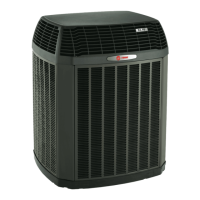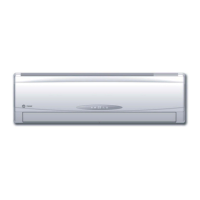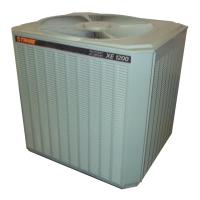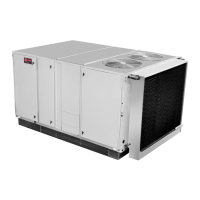Maintenance
OAU-SVX005C-EN 39
b. Check set-screws and bolts on the fan, bearings,
and burner assembly.
2. Monthly:
a. Check all valves, piping and connections for leaks.
b. Check the flame setting.
c. Check the fuel pressure in the fuel supply line to
each heater.
d. Check the burner manifold pressure at full fire.
e. Clean the flame sensor(s) or UV sight tube(s).
f. Inspect filters. Clean or replace as necessary.
g. Inspect the main fan bearings.
h. Check all dampers, damper actuators and linkages.
Adjust and tighten if necessary.
i. Ensure that there are no obstruction blocking the air
supply to the heater or the air discharge from the
heater.
j. Inspect the area and make sure that no combustible
or hazardous material has been stored within the
clearances as shown on the unit nameplate.
3. Quarterly:
a. Complete the monthly maintenance schedule.
b. Check the belt tension for the main fan(s) and adjust
if necessary.
c. Check the alignment of the sheaves and adjust if
necessary.
d. Inspect all bearings, set-screws for tightness and
lubricate bearings if necessary.
e. Check the pilot electrical system. Adjust if
necessary.
f. Check the pilot assembly. Clean and adjust if
necessary.
g. Inspect the burner carefully. clean and adjust if
necessary.
h. Check voltages and amp draw on main fan motor.
i. Check the operation of all safety controls
individually.
j. Check the operation of the automatic gas shut-off
valves and check them for leakage at the pressure
test ports provided.
k. On vertical units, inspect burner drip leg and drain
if necessary.
4. Off-Season/Yearly:
a. Complete the monthly and quarterly maintenance
schedule.
b. Inspect all fan wheels and housings. Clean if
necessary.
c. Check that all fan wheels and sheaves are securely
set on the shaft.
d. Inspect all bearings and alignment. Adjust if
necessary.
e. Inspect all V-belts. Replace if necessary.
f. Inspect all electrical components, connections, and
terminals. Clean and tighten where necessary.
g. Test ignition spark. Adjust gap if necessary.
h. Clean ignition electrodes and check for cracks.
i. Test flame safeguard relay and replace components
if necessary.
j. Inspect all regulators, relief valves, motorized
valves, solenoid valves, vent valves, manual shut-
off valves and safety shut-off valves. Check their
operation and clean as necessary.
k. Ensure all vents to the atmosphere are clean and
free from obstruction.
l. Inspect and clean all drip legs in the fuel line.
m. Lubricate fan motor as directed by motor
manufacturer.
n. Inspect fan motor wiring for loose connections.
o. Lightly oil all door latches.
p. Check that the cabinet is weather-tight. Replace
door gaskets and re-caulk as necessary.
Note: It is important to keep screened air intakes clear of
obstructions at all times.
Lubrication Requirements
Some blower motors require lubrication while others do
not. Those that require lubrication can be identified by the
presence of grease plugs in the motor casing at each end.
Motors that do not have grease plugs cannot be greased
and are lubricated for the life of the motor bearing.
NOTICE:
Belt Over-Tension!
Over-tensioning the belt could result in equipment
damage as it reduces fan and motor bearing life,
accelerates belt wear, and can cause shaft failure.
Table 8. Lubrication instructions
Item Manufacturer Bearing Type
All 3-PH Fan Motors (1
HP to 100 HP) ODP,
TEFC
U.S., Baldor™ or Equal
Single Row Ball
Bearings
All 1-PH Motors
(Fractional HP) ODP,
TEFC or TEAO
Century™, G.E.™, or
Equal
Bronze Sleeve
Bearings
Franctional HP 1-PH
ODP or TEFC
Century, G.E., or Equal
Bronze Sleeve
Bearings
Fan Shaft Bearings Fafnir or Equal
Self-aligning, Single
Row or Double Row
Ball Bearings, Resilient
Mounted
Dampers Applied Air™ or Equal Sleeve

